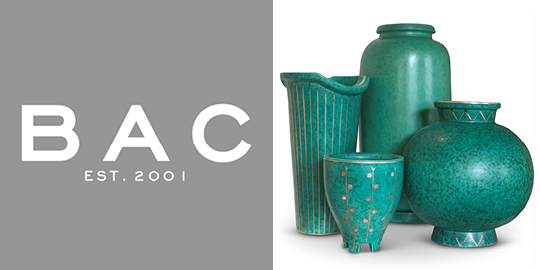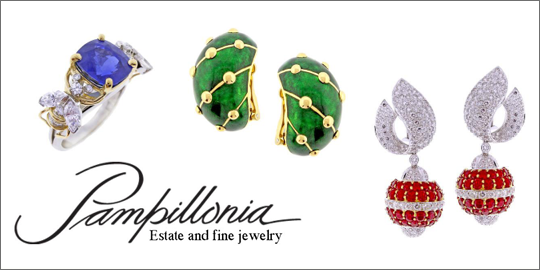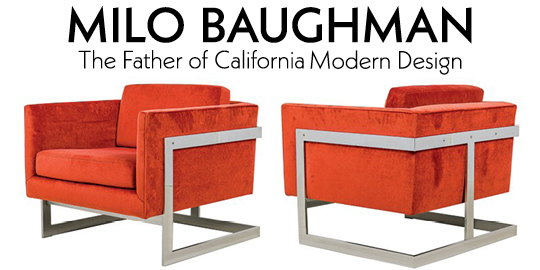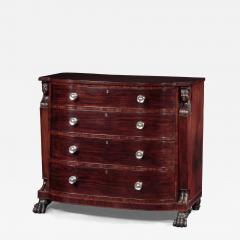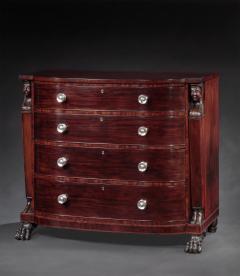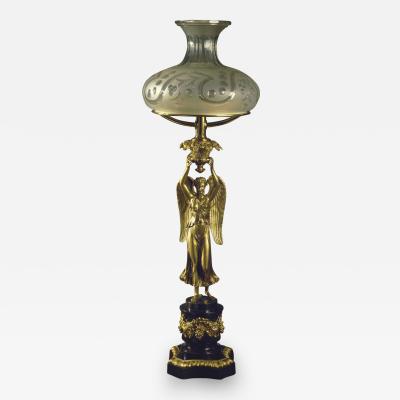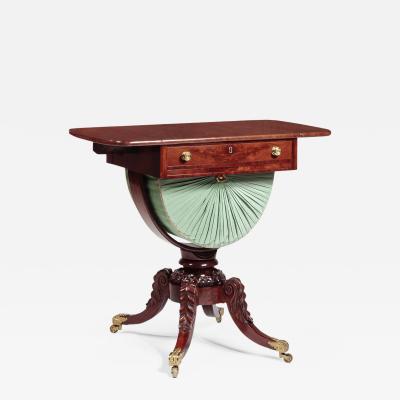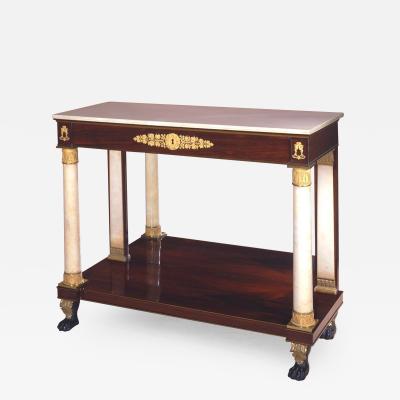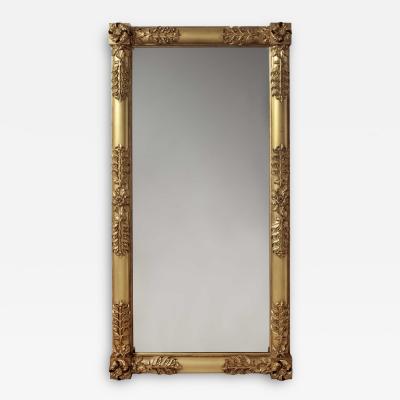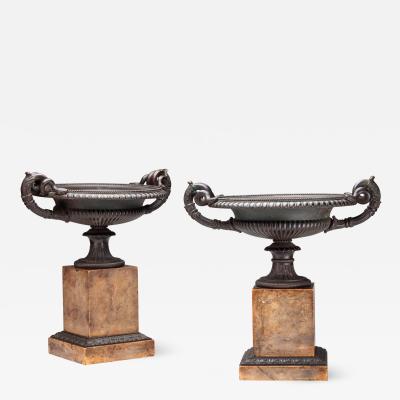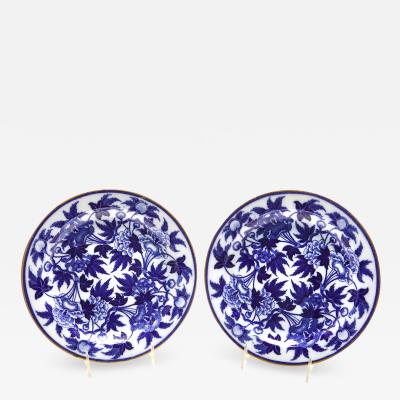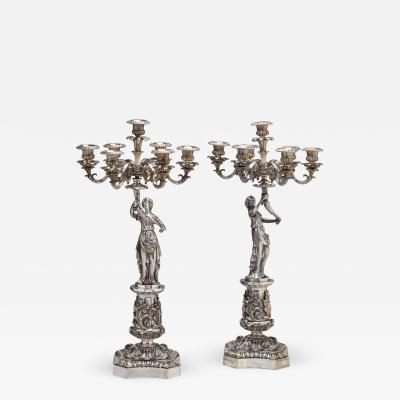Rare Carved Mahogany Elliptic Bureau with Egyptian Herms
-
Description
FINE AND RARE CARVED MAHOGANY ELLIPTIC BUREAU
WITH EGYPTIAN HERMS
In the Manner of Joseph B. Barry & Son (active 1810-1822)
Philadelphia, c. 1815
The Elliptic wood top over a conforming case with four graduated, bowed and cock-beaded drawers flanked by Egyptian-style herms with forward-facing female busts on tapering plinths above carved (human) feet resting on a conforming base raised on lion’s paw feet in front and turned stumps in back. Secondary wood: White pine.
H: 40.5” W: 47” D: 25”
Condition: Excellent, with period Sheffield silver replacement knobs. Brass escutcheon keyholes are replaced. Refinished with shellac in the manner of the period.
A small group of about a dozen elliptic chest with Egyptian figures is known and they have been attributed to Philadelphia master cabinetmaker Joseph Barry based on his advertisement in the March 30, 1815, Philadelphia Aurora General Advertiser where he touted “3 pair Elliptic Bureau, columns and Egyptian figures.” There are variations with many having “beehive-shaped” feet and some cases without feet sitting directly on the ground. Many have herms facing the side and a few have forward-facing herms. Some herms are male and some female. Some uncertainty persists among scholars about the authorship of the cabinets with herms as some were also made by Baltimore cabinetmaker Edward Priestley (1778-1837). Currently, all the elliptic bureaus except one are attributed to Barry while all the sideboards, desks and hunt tables with herms are attributed to Priestley. None is labeled or marked. It is noteworthy, however, that all the cases with forward-facing herms are attributed to Priestley whereas those with sideways-facing herms are thought to be by Barry. Additionally, the present example is the only one with carved lion’s paw feet supporting the case, which relates to feet on a sideboard with herms attributed to Priestley, published by Alexandra Kirtley (Kirtley, 123, fig. 24).
In the end, the arguments are academic and may never be fully resolved. What is important is that Barry and Priestley were the only American cabinetmakers who were known to use Egyptian-style herms on furniture, c. 1810-1830, in the manner of George Smith, and they were both cabinetmakers of consummate skill. As a result, all the furniture with carved herms are important and rare examples of American Classical furniture and are highly desirable.
HISTORICAL INSPIRATION
The most obvious and certainly the foundation of the concept of human figures supporting an entablature is the portico of the Erechtheion on the Acropolis in Athens. This seminal work of architecture dating to the age of Pericles was first published by Le Roy in Ruines des Plus Beaux Monuments de la Grèce of 1758. It is likely that this volume inspired the plate 176 of a table supported by female figures in Thomas Chippendale’s third edition of The Gentlemen’s Director published in 1762. In 1789, James Stuart and Nicholas Revett’s second volume of Antiquities of Athens illustrated the Erechtheion and re-focused the world on the beauty of Greek architecture. This volume was owned by the Library Company of Philadelphia shortly after its publication.
Students of Roman architecture, meanwhile, began to produce a flood of influential publications. Sir William Chambers (1723-1796) showed female herms flanking a mantelpiece in his Treatise on Civil Architecture (London, 1759) and Giovanni Battista Piranesi illustrated multiple examples of Greek and Egyptian-inspired herms in his 1769 volume Diverse Maniere d’Adornare I Cammini. It is Piranesi’s Egyptian inspired designs that are the most likely source of inspiration for both Barry and Priestly. This is because of the work inspired by Piranesi produced by Thomas Chippendale Junior for Sir Richard Colt Hoare at Stourhead, c. 1802 most likely influenced George Smith, whose pattern book of furniture designs would reach the United States by 1808.
French fashion and design may also have played a part. From the time of the Renaissance there had been an Egyptian influence in Continental design which stemmed from the intense interest of the Romans, themselves, in ancient Egyptian civilization. Thus, as the interest in Roman design spread in the 1760s, Egyptian motifs came with it. This explains Egyptian motif in Louis XVI furniture, particularly herms on commodes and chairs, Dugourc’s 1786 design for an Egyptian room at El Escorial outside Madrid and Marie-Antoinette’s cabinet de retait at Fontainebleau decorated between 1785 and 1787. Charles Cameron’s 1786 Egyptian Vestibule at Catherine the Great’s Pavlosk Palace in St. Petersburg is also the product of Le goût égypte.
Napoleon’s conquest of Egypt in 1798 only served to awaken, augment and spread an existing theme in French and Continental decorative arts. As a result, carved and gilt-bronze Egyptian-style herms are ubiquitous in Empire furniture. If this bureau or any American herm-carved furniture can be said to have French influence, this is surely its root.
Nineteenth century furniture designers in both France and England were quick to apply Greek and Egyptian caryatids and herms to modern furniture and interiors. Percier and Fontaine show many examples in their Recueil de décorations intérieures (Paris 1801-1812), including plates 23, 24, 28 and 49.
Thomas Sheraton shows female herms on a “Horse Dressing Glass” in plate 52 of the Dictionary, quite similar to those he would later use on designs in his Encyclopedia. An illustration of a secretary bookcase from Sheraton’s 1806 Encyclopedia that also shows herms at the top of pillars flaking the upper bookcase section.
George Smith’s Collection of Designs for Household Furniture published in 1808 is rife with the use of herms and caryatids on wardrobes, commodes, bookcases, library tables and sideboards. Sideboard plates 92, 93, 94 and 95 were clearly influential in the work of Barry and Priestly. Smith’s plate 118, showing “Commodes,” has one with drawers flanked by female herms and is raised on lion’s paw feet, closely related to the present example and clearly its inspiration.
By the late 1820’s the craze for herms and caryatids was over; Smith using the device in only one design in his 1828 The Cabinet-Makers and Upholsterer’s Guide and Peter and Michael Angelo Nicholson eschewing it completely in their 1826 Practical Cabinet-Maker, Upholsterer and Complete Decorator.
A related elliptic bureau with side-facing herms, attributed to Barry, is in the collection of the Museum of Fine Arts, Houston (accession #B2020.2)
Edward Priestley (1778-1837) was born in Annapolis, Maryland and arrived in Baltimore about 1790 where, it is likely, he apprenticed until he set up shop at 79 Water Street with Samuel Minskey in 1801. In 1806 they moved to Baltimore Street, but the partnership dissolved a year later, Priestley staying alone at 4 Baltimore Street where he would remain until his death in 1837. Priestley's cabinetmaking business met with success and grew. Many of Maryland's leading families were his clients. He also invested in lumber, real estate, railroad stock, nail manufacturing, and wharf and ship construction; diversification that is the hallmark of a successful cabinetmaker.
Joseph B. Barry, born in Dublin and trained in London, first appears in Philadelphia directories in 1794 in partnership with cabinetmaker Alexander Calder at 75 Dock Street, and by 1797 was on his own at 148 South Street. In 1809 Barry built and occupied a two-story brick building at 134 South Second Street where he remained until 1825: his most productive years. He is known to have visited England in 1811 where he acquired furniture and decorations and would have been directly exposed to Regency style. From 1810 to 1822 he took his son, Joseph Junior, as a partner. By 1830 he had relocated to 129 Walnut Street where he remained until retiring a year -
More Information
In the Style of: Joseph B. Barry Origin: United States, Pennsylvania Period: 19th Century Materials: Carved Mahogany Condition: Good. Excellent, replaced period drawer pulls Creation Date: c. 1820 Styles / Movements: Regency, Traditional, Neoclassical Book References: George Smith, A Collection of Designs for Household Furniture, (London: J. Taylor, 1808). Article References: Alexandra Alevizatos Kirtley, "A New Suspect: Baltimore Cabinetmaker Edward Priestley," American Furniture, Luke Beckerdite Ed. Hanover: Chipstone Foundation, (2000), 100-135. Dealer Reference #: C-2402061 Incollect Reference #: 833003 -
Dimensions
W. 47 in; H. 40.5 in; D. 25 in; W. 119.38 cm; H. 102.87 cm; D. 63.5 cm;
Message from Seller:
Welcome to Carswell Rush Berlin Antiques, a premier New York City-based dealer specializing in American antique furniture and decorative accessories from the Classical period (1800-1840). For inquiries, please contact us at 646.645.0404 or email carswellberlin@msn.com.








